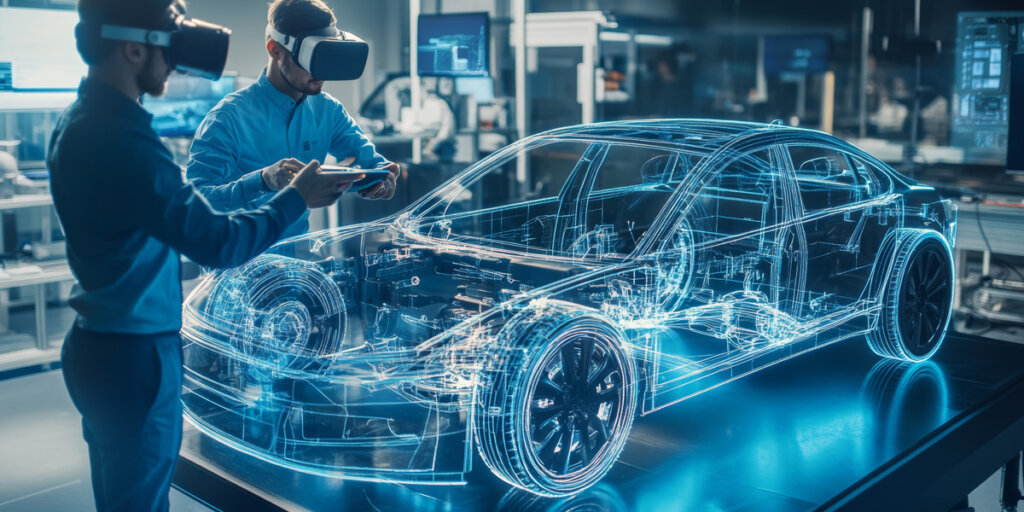Tech Talk is a series of interviews that introduce you to some inspiring personalities within and beyond the MD Group and the world of technology, innovation, and more.
In this edition, we met up with Li Dan, COO at MD Asia-Pacific (Beijing) ELECTRONICS Co., Ltd., & MD (China) ELECTRONICS Co., Ltd. She shares firsthand insights into the rise of Chinese automotive brands & their strategies. We explore the drivers behind their success, the technological edge they’ve built, and what lessons Western OEMs and Tier 1 suppliers can take from this rapid transformation.

Li Dan, please tell us a little bit about yourself. What has been your career path so far and what brought you to MD ELECTRONICS?
Hello, my name is Li Dan. I am 43 years old, COO at MD in China and mom to a seven year old son.
After graduating from university with a degree in industrial design, I joined MD in 2010.
Starting in the technical department, I worked in design construction & application engineering. I then had the opportunity to become a resident engineer at one of MD’s biggest OEM customers, allowing me to work closely with customers on site and to gain valuable insights into their day-to-day challenges.
From there I was promoted internally to production manager. In 2017 I became Operations Director at our plant in Beijing and since 2020 I am proud to hold the position of COO at both MD China locations.
I love the international aspect of my work and directly impacting our success on every level of the company. Having worked my way up over the past 15 years, I have first-hand knowledge of our processes and products, which is a major advantage in my current managerial roles. I am excited to see what the future brings, not only for MD Asia Pacific but for us globally as the MD Group!
Great, Xiexie – let`s get started: What has driven the rapid rise of Chinese OEMs in the global automotive market?
There are several main drivers, but if I had to pick just one word, it would be speed. Chinese OEMs move incredibly fast — whether it’s adopting new tech, launching new models, or responding to market shifts. Chinese automakers are more agile in responding to consumer trends than more traditional legacy carmakers. They offer frequent model updates and customization options and excel in software-defined vehicles (SDVs), appealing to younger, tech-savvy buyers. The Chinese government has prioritized the automotive sector as a strategic industry, offering subsidies, tax breaks, and R&D funding. Policies such as Made in China 2025 and the Dual-Credit Policy have boosted domestic Electric vehicle production and technological innovation. Infrastructure investments like the national EV (Electric vehicle) charging networks have further fueled market growth.
China is the world’s largest EV market, with companies like BYD, NIO, and XPeng leading in innovation. Early investments in battery technology especially by CATL—now the world’s largest EV battery producer — have given Chinese carmakers a competitive edge. Cost advantages in lithium-ion battery production have made Chinese EVs more affordable globally.
China’s vast supply chain and economies of scale enable lower production costs compared to Western carmakers, with domestic OEMs benefiting from vertical integration.
Competitive pricing strategies have made Chinese cars particularly attractive in emerging markets such as Southeast Asia, India, Latin America and Africa.
Chinese carmakers have embraced connectivity, autonomous driving, and AI-powered infotainment systems faster than many legacy OEMs. Tech giants like Huawei, Baidu, and Xiaomi have entered the car sector and accelerated smart car development.
How are Chinese OEMs differentiating themselves from established carmakers?
Essentially through connectivity, be that in innovation, new model development or data monetization.
Chinese automakers like BYD, NIO or Xpeng are embedding 5G-enabled V2X systems for real-time communication with traffic lights, road sensors, and other vehicles, improving safety and efficiency. And unlike traditional automakers that rely on dealership updates, Chinese EVs (e.g., Li Auto, Huawei’s AITO) receive monthly, or even weekly OTA (over the air) updates, enhancing features like autonomous driving, battery management and infotainment.
Companies like NIO and XPeng use advanced NLP (Natural Language Processing) for multi-command voice control, even with dialects. Chinese carmakers are also including AI personalization and third party app integration into their models. Cars learn driver habits like seat position, climate preferences, frequent routes and adjust automatically. Chinese EVs support WeChat, TikTok, Alipay, and other super-apps, turning cars into mobile smart devices.
Unlike Western automakers that rely on suppliers like Mobileye or NVIDIA for example, Chinese OEMs like XPeng (XNGP), Huawei (ADS 2.0), and Baidu (Apollo) develop in-house autonomous driving systems, allowing faster iteration.
Chinese brands are rolling out urban autonomous driving faster than Tesla’s FSD’s (Fully-Self-Driving Vehicles) in China, with geofenced robotaxi trials like Baidu Apollo in Beijing. And China’s complex traffic conditions generate vast real-world driving data, helping refine AI algorithms faster than competitors and offering them a data training advantage.
Subscription models have become commonplace in TV and media over the last decade. Chinese companies like NIO are now offering subscription-based features for battery upgrades, autonomous driving and connectivity services to generate recurring revenue.
China’s ride-hailing market is one of the largest and most dynamic in the world, shaped by fierce competition, rapid innovation, and strong government involvement. DiDi Chuxing currently dominates the Chinese market with around 70% market share and has an international partnership with BYD. Together with the other ride-hailing companies they collect large amounts of data to optimize routes, battery usage, and predictive maintenance.
Chinese OEMs utilize smart city integration and benefit from national cloud and data platforms, working closely with local governments on V2G (Vehicle-to-Grid) and V2H (Vehicle-to-Home) projects, allowing EVs to supply power back to the grid.
Furthermore, China’s Beidou Navigation System and state-backed cloud services like Alibaba Cloud or Huawei Cloud support real-time traffic management and cybersecurity.
What are the key challenges Chinese OEMs face when expanding to international markets?
Chinese OEMs face brand trust issues, regulatory hurdles, and geopolitical friction.
Chinese carmakers are still building recognition in Western markets compared to established players like Toyota, Volkswagen, and Tesla. They must work on Brand Awareness and convince consumers that their cars are good quality and reliable. Historically Chinese cars were seen as cheap and low-quality, though this perception is slowly changing with improved technology.
Safety and Emissions Standards are strict, particularly in the EU and North America and require costly modifications and vigorous testing. Further barriers are the scrutiny which Chinese EVs and smart cars face over data security and privacy laws as detailed in the EU GDPR and growing U.S. restrictions on Chinese tech.
Current geopolitical tensions and tech rivalry — such as Huawei-style bans on Chinese EVs over data fears — as well as high import taxes increase cost and create further roadblocks in Chinas bid to expand globally.
To avoid tariffs, Chinese automakers are investing in overseas factories, as we see with BYD in Hungary or SAIC in Thailand, and expanding collaborations with established suppliers like the MD Group. We at the MD Group are well positioned to assist our Chinese OEM customers in meeting international standards ensuring their vehicles are equipped with globally compliant data communication solutions.
How have partnerships with global Tier 1 suppliers evolved?
Here we are experiencing a shift from cost-driven alliances to technology-driven collaboration. Prominent collaborations in Autonomous Driving & Smart Cars are XPeng and Nvidia on Orin chips, or Li Auto with Hesai and Innoviz on LiDAR.
It is also becoming more common for Chinese OEMs to enter into co-development partnerships with suppliers for next-generation data transmission and connectivity solutions. At the same time, established Tier 1 companies like Bosch, Continental, and Valeo are setting up R&D centers in China to serve both local and global needs as they realize they must also move with the times to stay ahead of the competition.
MD has been investing in China since 2005 – with production facilities as well as sales and tech offices. With over 30 years automotive expertise, we provide tailored solutions that meet the specific requirements of OEMs worldwide, facilitating seamless integration into diverse vehicle platforms.
And finally – what lessons can Western OEMs and Tier 1s learn from Chinese automotive innovation?
While tradition matters, Western OEMs must become more agile and embrace faster development cycles to stay competitive.
In China, speed is one of the most important success factors, Faster Time-to-Market, Vertical Integration and Agile product development cycles. Chinese OEMs demonstrate rapid prototyping and flexible manufacturing, allowing swift responses to market changes.
Chinese companies focus on the integration of software and hardware in vehicle ecosystems to enhance user experiences and operational synergies. They also invest in in-house operating systems and consider software as a recurring revenue stream.
Customer-centric digital experiences, online direct sales models & community building initiatives are also great examples of how Chinese carmakers are forging a new era of automotive innovation. Personalized digital services are engaging tech-savvy consumers and fostering loyalty via apps, user events and things like battery-swap networks like the one from NIO with 2,400+ swap stations already in place all over China. Leveraging subscription models is also very popular in China.
Chinese OEMs such as NIO are also increasingly reducing car dealership dependence by using DTC (Direct-to-Consumer) sales models. X-Peng sells many of its vehicles directly over its online platform. Both improve profit margins and customer data control.
Chinese automakers dominate at home through speed, cost control, and tech while going global via localization, premium branding, and partnerships. Western carmakers must learn from China’s agility or risk falling behind in both emerging and developed markets.
Looking ahead – what’s the Chinese government’s plan for the next 10 years?
China’s government has laid out an ambitious 10-year roadmap for its automotive industry, focusing on technological dominance, green transition, and global market expansion. These plans will reshape both China’s domestic market and the global car industry. Here’s what we could be potentially looking at long term.
In China EVs will be the default choice with internal combustion engine cars marginalized within the new, “smart” cities with autonomous taxis and V2G energy networks. Chinese brands control 70%+ of the domestic market and foreign brands are reduced to niche roles.
Chinese OEMs will be in the Top 3 for global sales while Europe’s auto industry struggles without competitive EV supply chains. The US and China are decoupling in car technology with separate electric and autonomous vehicle chip ecosystems creating two competing tech worlds.
Emerging markets will be dominated by China such as Africa, Southeast Asia, India or Latin America will drive Chinese EVs.
Li Dan, many thanks for this interesting and in-depth conversation! Xiexie!



